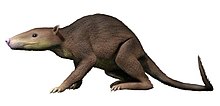Zalambdalestidae
| Zalambdalestes Temporal range:
| |
|---|---|

| |
| Zalambdalestes lechei skull and lower jaw, Museum of Evolution Warsaw. | |

| |
| Life reconstruction of Zalambdalestes lechei | |
| Scientific classification | |
| Domain: | Eukaryota |
| Kingdom: | Animalia |
| Phylum: | Chordata |
| Class: | Mammalia |
| Clade: | Eutheria |
| Order: | incertae sedis |
| Family: | †Zalambdalestidae Gregory & Simpson, 1926 |
Zalambdalestidae is a clade of Asian eutherians occurring during the Late Cretaceous. Once classified as Glires, features like epipubic bones and various cranial elements have identified these animals as outside of Placentalia, representing thus a specialised clade of non-placental eutherians without any living descendants, and potentially rather different from modern placentals in at least reproductive anatomy.[1][2]
Taxonomy
[edit]The exact position of Zalambdalestidae within Eutheria varies, though they are generally agreed to be more basal than zhelestids.[3] Currently, the clade includes the genera Zalambdalestes, Alymlestes, Anchilestes, Barunlestes, Kulbeckia, Zhangolestes and Zofialestes.
Palaeobiology
[edit]Zalambdaltestids were insectivores, having zalambdodont molars much as various modern insectivorous species. They are uniquely suited to a saltatorial, cursorial lifestyle, bearing long, semi-digitigrade limbs and a spinal column similar to that of modern lagomorphs.[4] Like most non-placental mammals, the presence of epipubic bones probably meant that they gave birth to poorly developed young much like modern marsupials and monotremes, though a study on multituberculate reproduction may suggest they and other early eutherians reproduced like modern placentals.[5]
A study on Zalambdalestes suggests they had an unique axial morphology. This allowed for quick prey capture, and may suggest they had spines or bristly fur in life.[6]
References
[edit]- ^ Wible, John R.; Rougier, Guillermo W.; Novacek, Michael J. (2005). "Anatomical evidence for superordinal/ordinal Eutherian taxa in the Cretaceous". In Rose, Kenneth D.; Archibald, J. David (eds.). The Rise of Placental Mammals: Origins and Relationships of the Major Extant Clades. Johns Hopkins University Press. pp. 15–36. ISBN 9780801880223.
- ^ Wible, J. R.; Rougier, G. W.; Novacek, M. J.; Asher, R. J. (2007). "Cretaceous eutherians and Laurasian origin for placental mammals near the K/T boundary". Nature. 447 (7147): 1003–1006. Bibcode:2007Natur.447.1003W. doi:10.1038/nature05854. PMID 17581585. S2CID 4334424.
- ^ Archibald, J. David; Averianov, Alexander (2012). "Phylogenetic analysis, taxonomic revision, and dental ontogeny of the Cretaceous Zhelestidae (Mammalia: Eutheria)". Zoological Journal of the Linnean Society. 164 (2): 361–426. doi:10.1111/j.1096-3642.2011.00771.x.
- ^ Chen, Meng; Wilson, Gregory P. (2015). "A multivariate approach to infer locomotor modes in Mesozoic mammals". Paleobiology. 41 (2): 280–312. Bibcode:2015Pbio...41..280C. doi:10.1017/pab.2014.14. S2CID 86087687.
- ^ Urton, James (July 25, 2022). "New study challenges old views on what's 'primitive' in mammalian reproduction". UW News. University of Washington. Retrieved April 6, 2024.
- ^ Arnold, Patrick; Janiszewska, Katarzyna; Li, Qian; O'Connor, Jingmai K.; Fostowicz-Frelik, Łucja (April 16, 2024). "The Late Cretaceous eutherian Zalambdalestes reveals unique axis and complex evolution of the mammalian neck". Science Bulletin. doi:10.1016/j.scib.2024.04.027.



